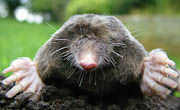©2010 Steven M. Smith
 Do you have a mole undermining the work of your team? Someone who constantly complains privately to any teammate who will listen but refuses to bring that same complaint publicly to the team? Someone whose actions are destroying teamwork?
Do you have a mole undermining the work of your team? Someone who constantly complains privately to any teammate who will listen but refuses to bring that same complaint publicly to the team? Someone whose actions are destroying teamwork?
A mole erodes productivity. Stop that mole now.
A team is like a garden. A good gardener manages pests -
Bambi, a deer, can kill a portion of your garden by eating your produce’s leaves. His attacks can be seen so they can be managed by the non-specialist, by using such means as scaring him; erecting a fence; planting produce that he doesn’t like; and using chemicals that make your plants smell or taste yucky.
Buck, a mole, undermines the roots of your garden killing your produce. But unlike Bambi, you can’t see Buck in action so his attacks are almost impossible to mange by the non-specialist. For instance, scaring him won’t work because you can’t see him; erecting a fence won’t stop him because he does his work under the surface; planting different produce won’t stop him because his food source is the worms, insects and grubs beneath your garden; and using chemicals to kill the insects and grubs won’t stop him because his primary food source is the worms.
Bambi’s behavior can be managed so that it is an annoyance. Buck’s behavior is much different — it’s destructive.
Real moles aren’t malicious. Their intention is to eat rather than destroy the garden. I admire them for their single mindedness and work ethic. I, however, disdain a mole on my team.
I believe the Bucks of the world think their actions are helpful. But unlike my ability to manage the Bambis, I don’t have the special skills necessary to consistently manage or turnaround the Bucks. And in my experience, I estimate that there are only 0.1% of all managers who have that special management (therapy) skill.
What’s to be done? Confirm you are dealing with a sibling of Buck’s by — bringing the tunneling behavior to the person’s attention, telling them it’s unacceptable, and determining whether the tunneling continues. If it does, work with HR to immediately rid yourself of them.
Once they’re gone, the team will feel like the weight of the world was lifted from their shoulders. Productivity will skyrocket. Stop that mole. Now.

Hi Bruce, Thank you for the comment and question.
I gather that you came to the conclusion that removing a mole from a team was a smart thing to do faster than me. I understood the concept intellectually but not emotionally. When I was at the point in my career when I had the power to remove the mole, I emotionally struggled with the implications of removing someone from the team. I believed that with understanding and help any person could become a good teammate. That belief might be true. But I took the concept too far and made it a rule that I must help individuals who were poor teammates. Despite how silly that rule may sound, it was true for me. Until someone can choose to remove the mole, knowing how to remove them doesn’t matter.
How do you remove a mole quickly? As you point out corporate policies may prevent the quick removal of a mole. But the team can isolate the mole to minimize destruction. I suggest using an old corporate method of assigning the mole to a role that effectively removes them from the team. For instance, assign them to a role where they research something for 30 days and then report back to the team. Something that eliminates interaction with other teammates. Keep assigning them research assignments until you can remove them. Although the team will be operating with one less person, its productivity will soar.